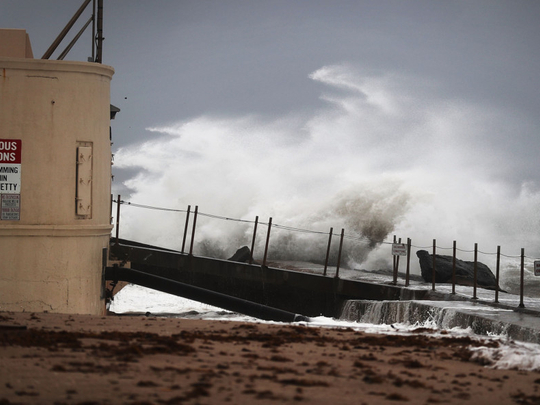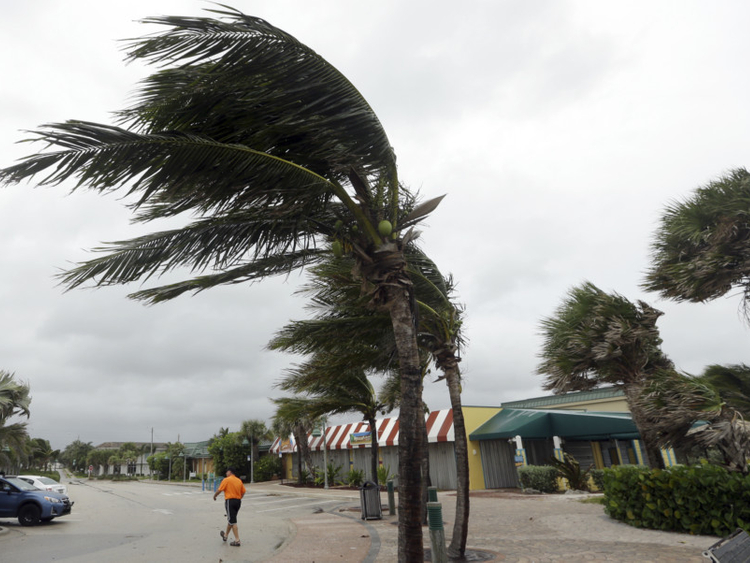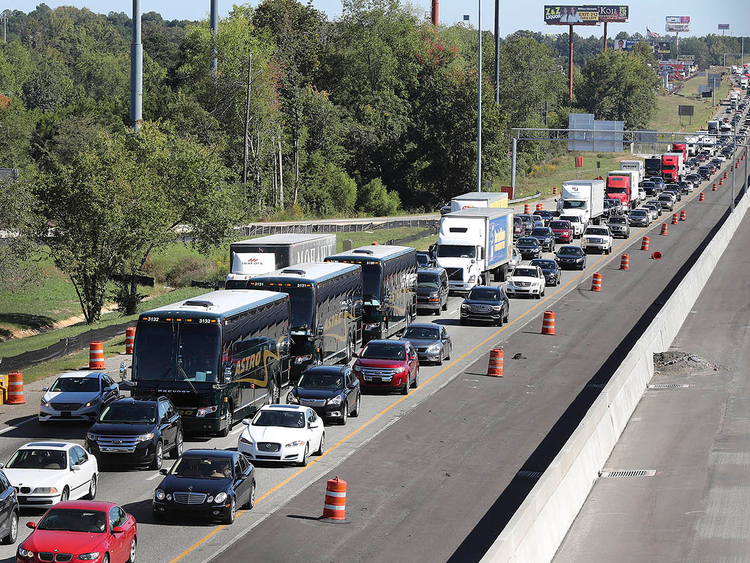
Hurricane Matthew, carrying winds of 195 kph per hour, lashed Florida on Friday and cut power to hundreds of thousands of homes as it hugged the state's Atlantic coast on a northward track after killing hundreds of people in Haiti.
Matthew, the first major hurricane to threaten a direct hit on the United States in more than a decade, triggered mass evacuations along the coast from Florida through Georgia and into South Carolina and North Carolina.
The hurricane could cause insurance losses of $25-30 billion and be the second costliest US hurricane on record for insurers, according to initial industry estimates.
Data modelling firm RMS has told clients its initial estimates were a 42 percent chance of a $20 billion insurance loss and a 26 percent chance of a $30 billion loss from the hurricane, a source familiar with the research said.
At 8am EDT (1200 GMT), Matthew's eye, or center, was 55 km east of Cape Canaveral, home to the country's main space launch site.
"The winds are ferocious right now,” said Jeff Piotrowski, a 40-year-old storm chaser from Tulsa, Oklahoma, who was near Cape Canaveral early on Friday. “It’s fierce.”
The storm downed power lines and trees and destroyed billboards in Cape Canaveral, he said.
Only a handful of hurricanes of this strength have ever made landfall in Florida, and none since 1898 has threatened to scythe its way north along the low-lying, densely populated coast into Georgia and beyond.
'I'm going to pray for everybody's safety'
The strongest winds of 120 mph were just offshore, but Matthew's wrath still menaced more than 500 miles of coastline.
"This storm's a monster," Florida Govrnor Rick Scott warned as Matthew started lashing the state. "I'm going to pray for everybody's safety."
The number of homes and businesses without power jumped by the hour as the storm edged closer to the coast. More than 200,000 were in the dark by early Friday.
The winds picked up along Vero Beach, midway between West Palm Beach and Cape Canaveral, stripping away palm fronds, ripping awnings and blowing sand that stung the face. Waves crashed on the beach, and rain came in short bursts.
Miami: Some three million people on the US southeast coast faced urgent evacuation Thursday as monstrous Hurricane Matthew — now blamed for more than 100 deaths in Haiti alone — bore down for a direct hit on Florida.
Highways in Florida and neighboring states clogged up with people streaming inland to escape the storm blasting in from the Caribbean, as officials warned people tempted to ride it out they may be risking their lives.
President Barack Obama declared a federal state of emergency in Florida as it braced for the ferocious Category Four hurricane, expected to bring beach-eroding waves as tall as two-story buildings and winds strong enough to snap trees and blow away roofs or entire houses.
Poor and vulnerable Haiti remained essentially cut in half two days after Matthew hit. Local officials said at least 339 Haitians have died, with 50 killed in a single town and reports of “complete destruction” in the island’s south.
In its latest target, the storm slammed the Bahamas Thursday, blowing off roofs, downing trees and knocking out power. Weather forecasters working out of Nassau airport had to flee for their lives.
According to the forecast track, the hurricane could make landfall in the United States near Cape Canaveral, where NASA’s Kennedy Space Center is located, by Friday morning.
As US gas stations ran dry, frantic shoppers flocked to stores for essentials.
They snapped up batteries, transistor radios, bread, canned goods, bottled water, ice and pet food to gird for what Florida Governor Rick Scott warned would be a devastating, killer storm, with winds howling at up to 240 kilometres per hour.
“Evacuate, evacuate, evacuate,” he told a news conference. “Time is running out.”
The region’s strongest storm in years, Matthew regained power as it swirled toward the US coast, upgraded a notch to Category Four Thursday by the National Hurricane Center on its 1-5 scale.
‘Body bags’
In Myrtle Beach, South Carolina, the normally bustling resort turned into a ghost town as tourists loaded up cars, cut short vacations and fled north.
“It was packed with people here yesterday and then we came today and it was like ‘Oh my God there is nobody here’,” Kelly Allmendinger, a 26-year-old bartender whose family was one of only two left on the eerily deserted beach.
Despite the mass flight, officials warned a worrying number of people were not heeding the evacuation order.
“People do not seem to get it and are not leaving,” Sheriff William D. Snyder from Martin County, Florida, told NBC News.
“I’m not saying this to be theatrical... I asked my captain of detectives if he had body bags, because if we get 140 mile-per-hour winds in mobile home parks, we are going to have fatalities.”
The fire service in St Augustine, northern Florida, issued a video message on Facebook warning that damage to the city was expected to be “catastrophic” and urging all holdouts to leave.
“We as a city are evacuating,” said Fire Chief Carlos Aviles. “I cannot emphasize enough: we are encouraging you to leave.”
“If you are choosing to stay in St Augustine, you are choosing to do so at your own risk. There will be no public safety personnel to assist you.”
18-foot waves
Some 1.5 million coastal dwellers are under an evacuation order in Florida alone. More than a million others in South Carolina and other coastal states were also told to escape the path of the storm, which first made landfall in Haiti Tuesday.
Mandatory evacuations were also ordered in six coastal counties in Georgia that are home to some 520,000 people.
Some 6,000 US Marine recruits were evacuated from a base at Parris Island, South Carolina.
Miami International Airport canceled 90 percent of its incoming and outgoing flights on Thursday and Walt Disney World — in Orlando, 35 miles inland from the Atlantic — was to close early on Thursday and stay shut Friday.
President Obama’s emergency decree frees up resources to help Florida and authorizes the federal government to coordinate relief efforts.
Obama spoke with the governors of Florida, Georgia, North Carolina and South Carolina, pledging to provide them with all necessary federal resources to cope with the storm.
Both presidential candidates sent out messages of support to those affected, with Republican Donald Trump saying “Please stay safe” while Democrat Hillary Clinton urged people to heed evacuation orders, tweeting: “Stay safe Florida.”
The National Hurricane Center said waves whipped up by the hurricane could reach as high as 5.5 metres — nearly as tall as a two-story building. Debris tossed into the air will be capable of blasting through buildings and cars, the NHC said in a bulletin.
Scott said the forecast is for storm surges of five to nine feet (1.5 to 2.7 meters), not counting the waves on top of that.
Power outages, possibly lengthy, are a near certainty.
‘Running out of food’
As Matthew barreled northwest, Caribbean nations continued the grim task of assessing damage and fatalities, with four dead in the Dominican Republic in addition to the surging toll in Haiti.
In Cuba, where some 1.3 million people were evacuated, there were no reported fatalities, but four cities in the east were cut off because roads were blocked by large chunks of rock hurled by the storm.
Haiti postponed a presidential election scheduled for Sunday as it reels from the strongest storm to make landfall there in half-a-century.
In one southern department alone, 29,000 homes were destroyed, the interior minister said.
In Haiti’s southern city of Jeremie, “about 80 per cent of the buildings are gone,” tweeted Jean-Michel Vigreux, country director for the CARE relief agency. “All phone lines and electricity are gone. Access is completely cut off, and everyone is running out of food and money.”
Further south in Les Cayes - home to a major port - an AFP reporter found the cathedral’s roof completely blown off.
The town of Roche-a-Bateau, where at least 50 died, was also devastated, local lawmaker Ostin Pierre-Louis told AFP. “No one’s house is left standing.”














